RTI's evidence-based research on Oregon's Drug Addiction Treatment and Recovery Act
Objective
To understand the impacts of drug decriminalization in Oregon through 911 calls for service data.
Approach
Publicly available calls for service data were used to compare Portland’s use of the 911 system with Boise (ID), Sacramento (CA), and Seattle (WA) before and after Ballot Measure 110’s (BM 110) implementation. Data were examined between January 2018 and July 2022.
Impact
Public-initiated calls for service did not change after BM 110 was enacted in Portland. Portland 911 calls for service data align with comparison cities for property, disorderly, and vice offenses, with similar seasonal fluctuations.
Oregon’s Ballot Measure 110: Drug Addiction Treatment and Recovery Act
In November 2020, nearly 60% of Oregon voters approved Ballot Measure 110 (BM 110), also known as the Drug Addiction Treatment and Recovery Act. Enacted in February 2021, Ballot Measure 110 decriminalized non-commercial drug possession and significantly increased funding for substance use disorder treatment and harm reduction services through newly established Behavioral Health Resource Networks. Although drug decriminalization was enacted immediately, most of the funding for treatment and harm reduction services was not awarded until August 2022—19 months after Ballot Measure 110 took effect.
What the Passage of Ballot Measure 110 means for Oregon
With Ballot Measure 110’s passage, Oregon is the first U.S. state to decriminalize non-commercial possession of drugs that are illegal under the federal Controlled Substances Act. Several other states are considering similar legislation and are looking at Oregon’s BM 110 experience to shape how they proceed.
RTI International’s Evidence-Based Study on the Impacts of BM 110
RTI recently received a 4-year grant from the philanthropic foundation Arnold Ventures to conduct an independent outcome evaluation of BM 110. Given delays in the funding of treatment and harm reduction services, we first prioritized evaluating the impacts of drug decriminalization.
Criminal Legal System Representatives’ Perceptions of Ballot Measure 110
To understand perceived impacts of drug decriminalization from BM 110, our team visited four geographically distinct Oregon counties in the summer of 2022: two urban counties with populations of more than 250,000 and two rural counties with populations of 90,000 or less. We conducted 34 hour-long interviews with representatives from law enforcement (officers and leadership), emergency medical services/fire, district attorney offices, community corrections, juvenile justice, and the treatment and harm reduction communities. We asked participants about their perceptions of how BM 110 has impacted law enforcement in their communities and agencies.
Given the lack of available data, the 34 study participants we interviewed were curious about Oregon’s crime rates before and after BM 110 and how those rates compare with rates in other states or cities. Criminal legal system representatives perceived that crimes in general—and property-related crimes and disorderly offenses, in particular—had increased following BM 110’s implementation. They also perceived that public opinion in Oregon has soured on BM 110 because Oregonians feel like they are witnessing and being victimized more by crimes as a result of the ballot measure.
Notably, many of the 14 non-criminal legal system representatives we interviewed expressed that any alleged increases in crime could simply mirror what other communities and cities throughout the country are experiencing. In essence, they noted that COVID-19, civil unrest following the murder of George Floyd, increases in inflation and poverty, decreases in affordable housing, and the rapidly changing drug market introducing fentanyl were all equally plausible explanations for potential increases in crime.
Finding Answers in Calls for Service Data
Given the urgency of the data request from our qualitative study participants, our team turned to publicly available, computer-aided dispatch data, which are more commonly referred to as 911 calls, or calls for service (CFS) data. Our team is well-versed in helping law enforcement leadership use CFS data to inform resource allocation. For the purposes of the BM 110 evaluation, CFS data provide a unique view into a community’s concerns and needs by showing how much police are being called by the public to respond to particular types of incidents.
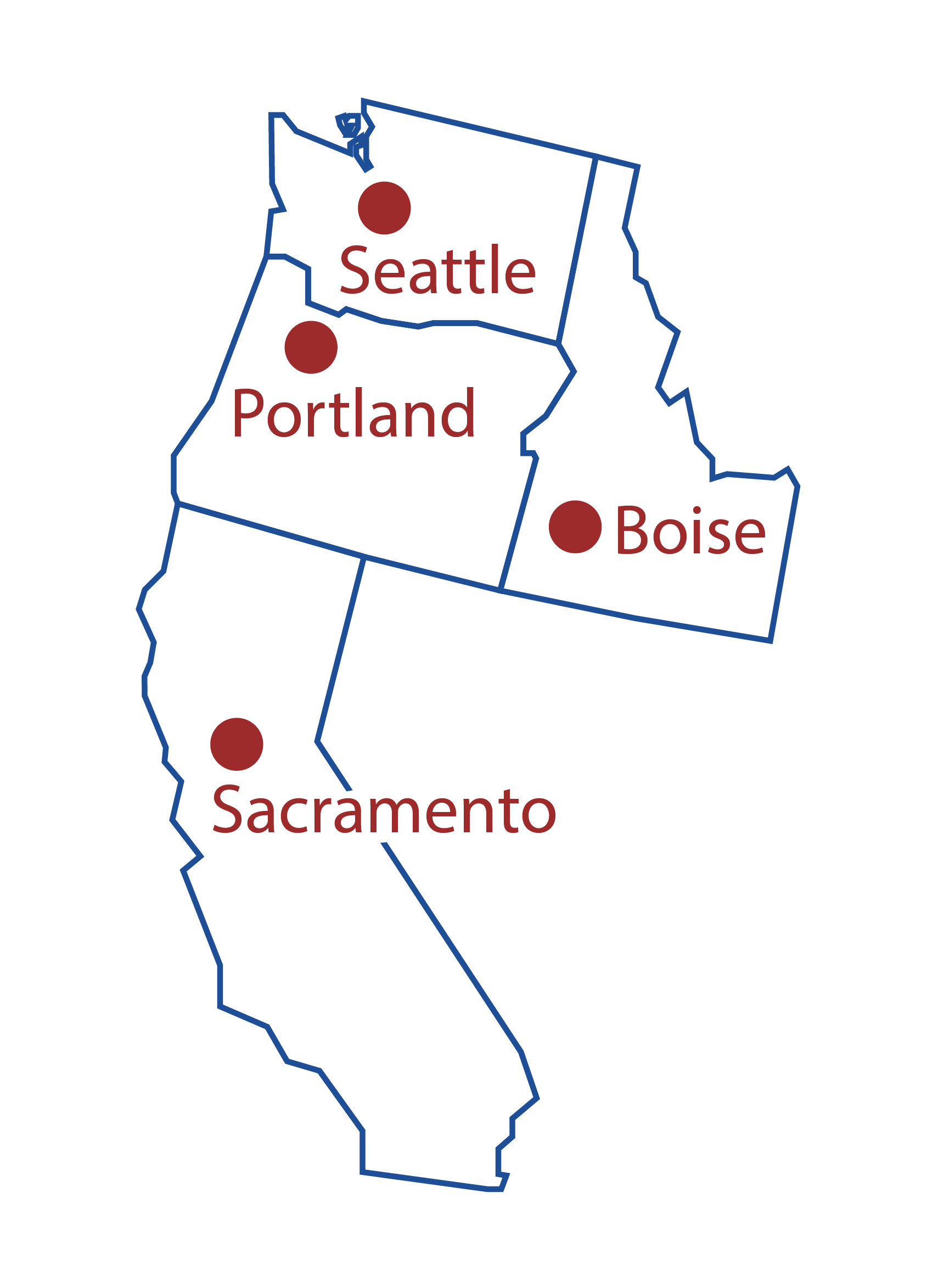 For this initial analysis, Portland was selected as the chief Oregon site because it is the state’s largest city and its CFS data are publicly available. We chose comparison cities in neighboring states that have not enacted BM 110 and for which data were available. Based on 2021 Census statistics, two of the selected cities are reasonable comparisons to Portland (population: 652,503) in terms of size and region: Seattle, Washington (population: 737,015) and Sacramento, California (population: 524,943). Sacramento and Seattle are more racially diverse than Portland. Boise is the largest city in neighboring Idaho (population: 235,684), which is in the same region but is smaller than the other three cities, and with racial demographics that are more similar to Portland. Age and sex demographics are similar across all four cities. Notably, the universe of Portland CFS data is dispatch only, meaning that only calls initiated by residents are included. Thus, we used the same criteria for data from the three comparison cities. A total of 4,162,620 calls for service were collected and analyzed across the four cities between January 2018 and July 2022.
For this initial analysis, Portland was selected as the chief Oregon site because it is the state’s largest city and its CFS data are publicly available. We chose comparison cities in neighboring states that have not enacted BM 110 and for which data were available. Based on 2021 Census statistics, two of the selected cities are reasonable comparisons to Portland (population: 652,503) in terms of size and region: Seattle, Washington (population: 737,015) and Sacramento, California (population: 524,943). Sacramento and Seattle are more racially diverse than Portland. Boise is the largest city in neighboring Idaho (population: 235,684), which is in the same region but is smaller than the other three cities, and with racial demographics that are more similar to Portland. Age and sex demographics are similar across all four cities. Notably, the universe of Portland CFS data is dispatch only, meaning that only calls initiated by residents are included. Thus, we used the same criteria for data from the three comparison cities. A total of 4,162,620 calls for service were collected and analyzed across the four cities between January 2018 and July 2022.
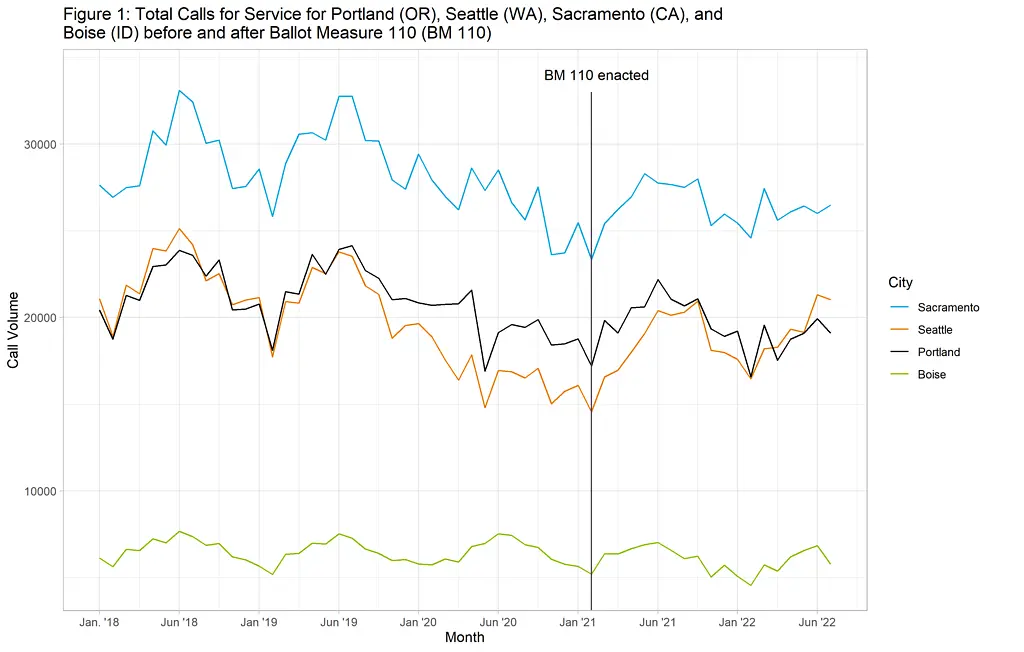
Figure 1 shows the overall CFS data across all four cities before and after enactment of BM 110 in February 2021 (demarcated by the black vertical line). Overall, trends in Portland are similar to trends in comparison cities, with no significant increases in people calling 911 after BM 110 was enacted. All four cities show seasonal fluctuations in CFS data, with increases in summer months and decreases in winter months.
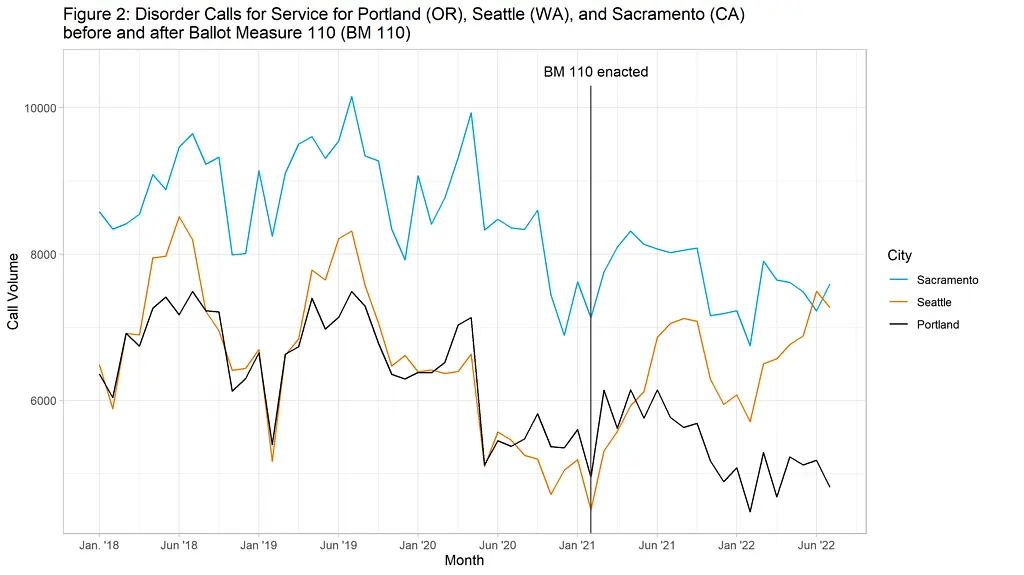
Figure 2 shows the trends in disorder calls (e.g., vagrancy, unwanted person, and disturbances) across three cities but does not include Boise because publicly available Boise CFS data do not include this crime category. As shown, 911 calls for disorder crimes have not increased discernably in Portland following enactment of BM 110, but are actually somewhat lower. Portland’s trend line generally follows the pattern of Sacramento.
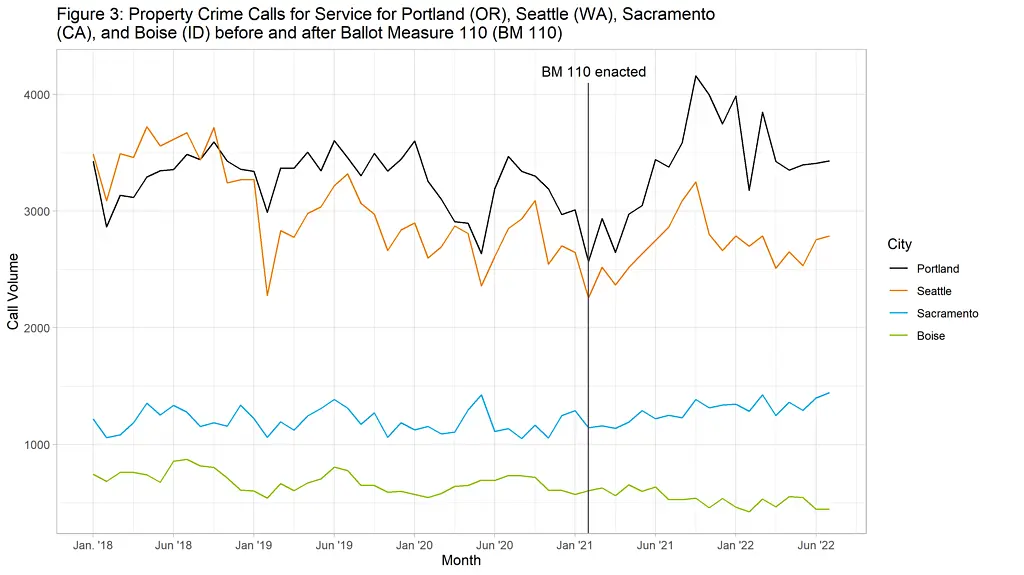
Figure 3 shows the trend lines for property crime calls across the four cities. Sacramento and Boise’s trend lines were relatively flat throughout the period, whereas Portland and Seattle’s trend lines showed seasonal increases in property crime calls during the summer months, including 2021. Coinciding with civil unrest following the murder of George Floyd, Portland’s slight increase in property crime calls persisted into late fall of 2021. Property crime calls then dropped precipitously in the winter of 2022 and have since flattened. Notably, the number of property crime calls in July 2022 (our last data point) was essentially the same as the number reported in July 2018, July 2019, and July 2020, before enactment of BM 110.
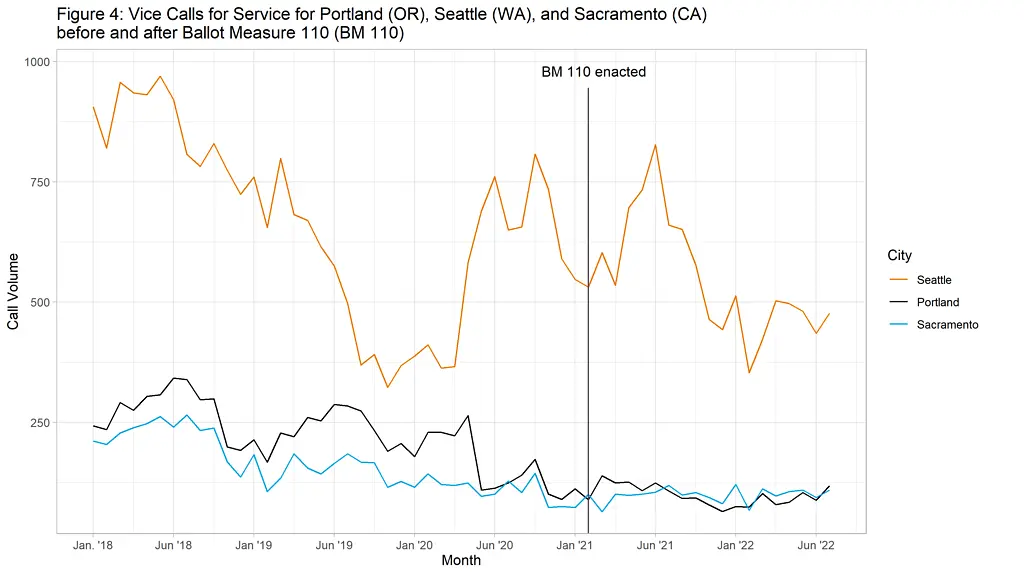
Figure 4 shows the trend lines for vice calls (e.g., calls related to drugs, alcohol, prostitution, gambling) across three cities but does not include Boise because publicly available Boise CFS data do not include this crime category. Overall, Portland’s trend is similar to Sacramento’s, with the overall trend being slightly lower since BM 110 was enacted. The number of vice calls was much lower in Portland and Sacramento than in Seattle.
Summary of Initial Findings: The Volume of 911 Calls Did Not Increase After Ballot Measure 110
Our preliminary findings show:
- The public’s use of the 911 system did not change significantly after BM 110 was enacted in Portland;
- Portland 911 calls for service data track very closely with data from comparison cities in nearby states for property, disorderly, and vice offenses, with similar seasonal fluctuations; and
- The CFS data do not support the negative perceptions of BM 110 that were expressed by the criminal legal system representatives we interviewed in Oregon.
The calls for service trends presented herein are descriptive and merely reflect calls for service data that were publicly available across Portland and its comparison cities; they are not presented to suggest any causality as it relates to Oregon’s Ballot Measure 110.
In the coming months, our team will continue to evaluate CFS data from these cities and will collect CFS data from other cities when possible. CFS data provide a good gauge of public concern and show how law enforcement agencies are spending their time and resources. Moving forward, we will also examine incident-level data across the state of Oregon and compare these data to other states using 2021 National Incident-Based Reporting System data.
Now that Behavioral Health Resource Network funding has been awarded to all 36 Oregon counties (as of August 2022), our team will closely monitor the use of evidence-based health interventions, drug use and drug-related health outcomes, treatment uptake, experiences of people who use drugs, and the budget impact of BM 110. We will publish our findings in peer-reviewed literature in the coming months
For more information on RTI International’s policing research, evaluation, and technical assistance, visit https://www.rti.org/practice-area/policing.
- Arnold Ventures









